03 September 2022, 18:24
By Matt Hempy, Sustainability writer for Realty Sage
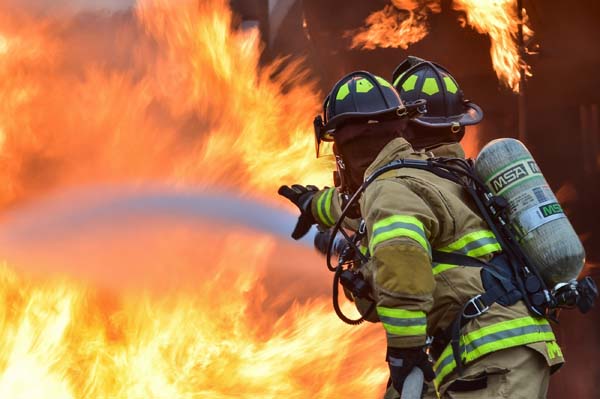
Preparing your home for a wildfire can be a daunting task. It is a horrific situation that we never think will happen to us. However, in an increasingly warming earth devoid of much-needed rainfall, wildfires seem to be only increasing.
I need not convince you of how devastating wildfires are; you've seen news stories of California homes engulfed in bright orange flames, scenes of an apocalyptic San Francisco when the skies, horizon to horizon, shared the color of its famed bridge. It is serious and scary. However, I will remind you that preparing will go a long way. The materials you build your home with, its structure, and your home's landscaping, among other factors, can be the difference between a "close call" and burned photo frames with nothing but ash inside.
In 1993, a horrific fire in Laguna Beach quickly swept up over the dry coastal sage landscape, racing through dry canyons, resulting in the loss of over 400 homes and millions of dollars of property damage. However, not every home in the fire's merciless path became a pile of ash. Each home in the fire's way that did not fall shared common denominators, including insulated walls, minimized venting, and other structural differences. One house in the fire's path boasted a 40-foot strip of ice plant, a succulent plant filled with water. This plant barrier between the home and the flames saved the house and the memories within it. Regardless of whether the owners realized the importance of this feature, it kept their homes.
Fire season in the United States has arrived. In some areas of the US, there is no "fire season" anymore, and the fire risks are year-round. Regardless of your state, preparing your home for a fire is an investment in your home ensuring it can survive these risks for decades to come.

Courtesy of kunc.org
Materials for a Fire-Resistant Home
As a general rule of thumb, fire-resistant homes use concrete and metal over combustible materials like wood. Below are materials that you should consider for your home.
Roofs: How to Create and Maintain Fire-Resistant Roofs
The most significant component of any house is the roof. It is also one of the most vulnerable components. Having a fortified roof with class A-rated materials, such as asphalt composition shingles, concrete, or fiberglass composition shingles, with non-combustible materials is crucial. One common way roofs catch fire is from embers that land on the roof (FEMA). Embers are known to fly up to a mile away, which is why fires can spread over long distances quickly. The three key components for a fire-resistant roof are both design, maintenance and material type A roof’s design should have minimal peaks and valleys. Roof valleys are excellent places for embers to rest increase the change of starting a fire. They should also have steep grades. Maintenance is also important, make sure to seal any gaps or openings around exterior walls or roofs and clean out gutters where dead leaves and other debris can build up. Covering up these gaps and weak points prevents embers from entering your home, and provides additional oxygen pathways for the fire.

Steep roof with asphalt shingles being installed. Courtesy of basc.pnnl.gov
Walls: A protective barrier for your home
Similar to roofs, the material of your walls can make or break its defense system against a fire. FEMA does not recommend wood and other combustible materials, instead encouraging earth and concrete systems such as stucco, rammed earth, or cement, are fire resistant and a better choice.
Two common types of fire resistant construction are Insulated Concrete Forms (ICF) and Structural Concrete Insulated Panels or Structural Insulated Panels (SCIP/SIP). They are both valuable, prevent fire, and allow for great indoor air quality. In short, ICF is two boards with concrete in between them, and SIPs are prefabricated panels.
IFCs are heat and fire-resistant materials known to hold off the fire for up to four hours. ICFs are used for roofs or walls and are an excellent way to ward off fire.
. 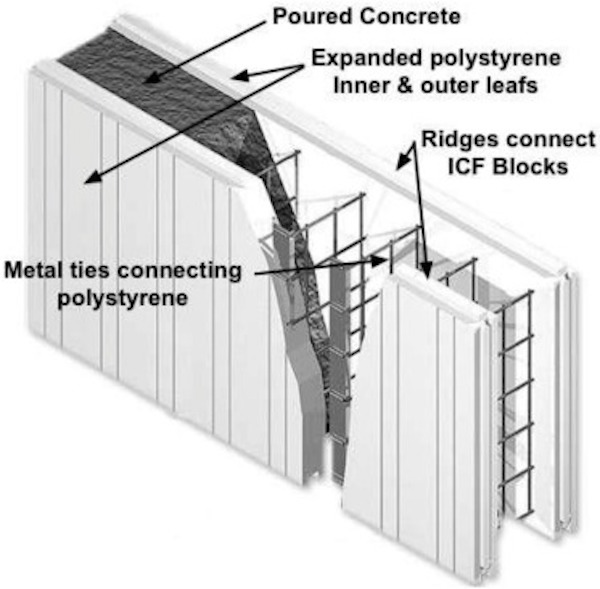
SCIPs have high insulation value, a concrete skin, and thermal mass, which means that it has materials which are able to absorb, store, and release heat. The roof can be made out of SCIP as well.
SCIP’s and ICF’s are two good materials, yet have have their differences. ICF’s are more fire resistant than SCIP’s, however are not as suited for large parts of roof compared with SCIP’s. Both types will reduce energy costs in your home and are sustainable ways to construct walls of your home (attainablehome.com).
An alternative option are earth-based systems. Called Rammed Earth or Pise (building material of stiff clay or earth) it is essentially earth packed down in various layers. It has a high mass material has is naturally fire resistant.
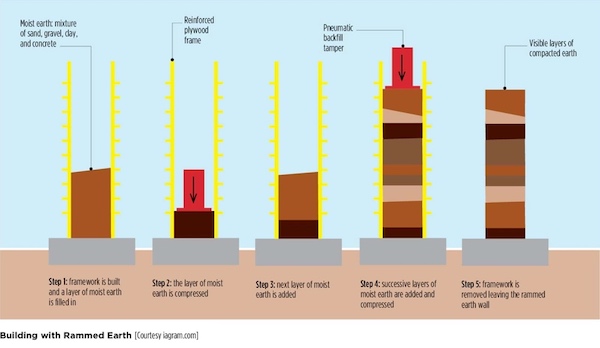
Windows:
Windows are typically seen as the weakest link of the house in the face of fire, breaking when faced with high heat, allowing the fire to enter the home. A few recommendations from the Federal Emergency Management Agency are to use multi-pane glass, tempered safety glass, and fireproof shutters over your windows.
Landscaping for a Fire-Resistant Property
Now that the exterior of your home is on its way to being fire-resistant, let's look at mitigating the effects of fire from your yard. The strategies that you put in place in your landscape can prevent a fire from reaching your home in the first place.
Creating Defensible Space Zoning
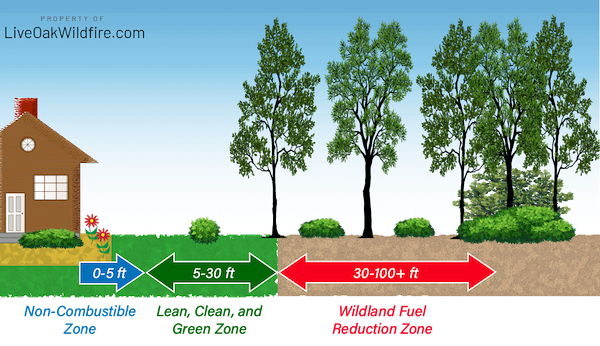
Courtesy of Live Oak Wildfire
Zone closest to your house:
The first five feet of your home should be free space with fire-resistant materials like rock mulch, gravel, or other non-combustible material. These five feet act as a barrier beside your home and are the first "zone."
The green zone:
After this is a green transitional zone, which begins five feet from your house until approximately 30 feet away. In this zone, it is essential to properly maintain your landscape and eliminate anything that will fuel the flames. Pick up dead and dry vegetation, dry leaves, and other things that could be kindling for incoming fire. If you have a lawn, mow regularly and keep its length below 4 inches. In this transitional zone in your yard, plant native, low-growing, fire-resistant plants with high water content such as succulents. Use this native plant guide to find plants for your location. Place plants intogroups spaced evenly around your landscape. Spacing prevents a direct path for the fire. Placing gravel, rock, or a stone walkway or patio between these groups of plants will help break up a fire's path.
If your property extends beyond 30 feet, you should consider this the third zone, which can beleft in its natural state. However, still try to maintain this area by trimming plants and picking up leaves which can fuel a fire
Types of Fire-resistant Landscapes
Xeriscaping
- Landscaping your home using native, drought-tolerant plants that require minimal water use is often called xeriscaping. This type of landscape reduces fire hazards, it will also save you considerable costs in water usage and time spent gardening. In a world where water is increasingly scarce, saving as much water as possible is vital.
- Xeriscaping can be very beautiful as well. For example, a xeriscaped yard in the westarn part of the United States could include daffodils, ocotillo, cactus, agave plants, herbs and spices like thyme, sage, oregano, or food plants like Jerusalem artichokes and black walnuts.
- Xeriscaping is practiced in the Western United States, in states like California and Arizona, but can be incorporated everywhere, even in Northern New England. As water becomes more scarce and wildfires become more common nationwide, a xeriscaped yard is a great strategy to fight against climate change-induced issues. All it takes to xeriscape is researching what plants are drought-friendly and native to your area and the initial time and cost required to implement this water and money-saving strategy.
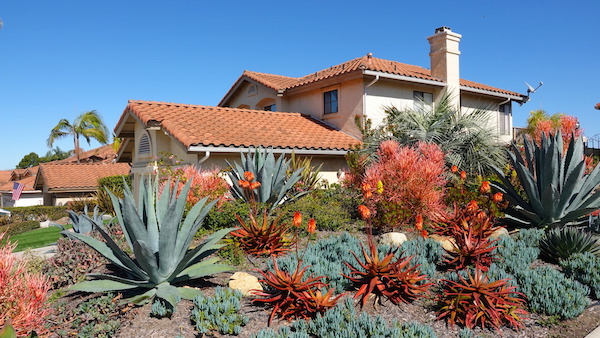
Courtesy of Xeriscaping saves water, adds beauty - AgriLife Today
Prepare for Wildfire and Drought
Droughts and wildfires typically can go hand in hand.o if you are preparing your home for a potential wildfire, there is a good chance that you live in a drought-risk area. As regions experience droughts, landscapes become drier, and vegetation becomes much more flammable. A staggering 85% of wildfires in the US are human-caused, and droughts exacerbate their horrific effects. Thus, it is necessary to be prepared to counter both natural disasters.
The best way to prepare for drought or act when a drought occurs is to preserve as much water as possible both inside and outside the home.
Indoor water-saving strategies
-
Fix faucets/plumbing from dripping
-
Buy water-efficient appliances such as low-volume toilets and showers. Toilets and showers are the two most significant sources of water consumption inside the home. Check out our recommended energy-efficient appliances here.
-
Don't let the water run while you brush your teeth, wash your face, shave, etc.
-
Wash your clothes on full loads
-
Don't run water to thaw meat (thaw overnight or in a microwave)
Outdoor water-saving strategies
-
Xeriscape your yard
-
Use drip-line irrigation methods, which are more efficient than regular sprinklers.
-
Use smart irrigation systems which can help detect when the plants need watering and when they’ve already had a good soaking from rain.
-
Mulch around trees and plants helps retain moisture in the soil
-
Over-fertilizing a lawn increases the need for water
-
Gray Water Systems (See below for more information)
To learn more about drought preparedness, here is an excellent summary from the Red Cross.
Greywater Systems
A great way to combat drought and preserve water is using a greywater system. A greywater system takes lightly used water from showers, laundry, and baths and uses it to water your garden. It can account for 50-80% of a household's wasted water, saving you considerable costs! Many people wonder if using this water is safe for plants, but if you are using safe cleanses and body products, it can be even more beneficial than regular water, as grease, dirt, hair, and food are fertilizers.
Grey water systems direct used water from the home to a container or tank and then discharge it into your irrigation system. A professionally installed greywater system can be anywhere from $800-$4000, but Elemental Green notes with $1500, you can expect an excellent greywater system, depending on the design and its capacity.
However, if you are looking to save some money and are good with your hands, then you can follow the steps of Dylan Crosbie, who DIY'd a greywater system costing him just over $500. Excellent work, Dylan! A self-installed straightforward laundry-to-landscape greywater system will only cost you $150-300!
Either way you add a greywater system, the costs are very well worth it. First, homes can save tens of thousands of gallons of water a year; according to the Waterwise Group, this figure is up to 40,000 gallons per year! And in some parts of the country, where the cost of water is significantly higher, it can add up to a lot of cost-savings too.

Courtesy of ClimateBiz
Intersections between Fire Resistance and Green Homes
Like many parts of our societal fight against global warming, costs and efforts often have multiple advantages. While a fire-resistant home can help deter fire damage and destruction, it can also reduce its impact on climate change by utilizing energy-efficient building techniques and water-saving features. If we can combat climate change, we may be able to reduce the increasing number of wildfires and droughts. That’s why green homes are ideal for anyone.
In Hollister, California, one green home stands out among the rest. This home is a perfect intersection of eco-friendliness and fire resistance, built by the Sustainable Innovative Design and Construction (SIDCO). Taking an existing green home model, SIDCO founder and CEO Mohan Mahal incorporated fire-resistant materials, including Eco-Smart Structurally Insulated Panels and other non-combustible materials. The home was equipped with solar panels, a Tesla power wall, a heat pump, and water-conserving irrigation. The home boasts a 10/10 Home Energy Score from the Department of Energy. As wildfires spread, droughts increase, and energy costs soar, homes like this Hollister house can act as a model for eco-friendly and fire-resistant buildings.

Courtesy of einnews.com
Conclusion
Spending the extra money to create a fire-resistant home and yard could save a lifetime of costs on water and energy, as well as the costs should your home be damaged or destroyed from fire. It also gives you peace of mind that you have a home that is prepared for some of the worst possible conditions and is a positive step to combatting climate change. If we build differently now, our homes will survive for a long time.
Main image source Photo by Pixabay
Back to news

